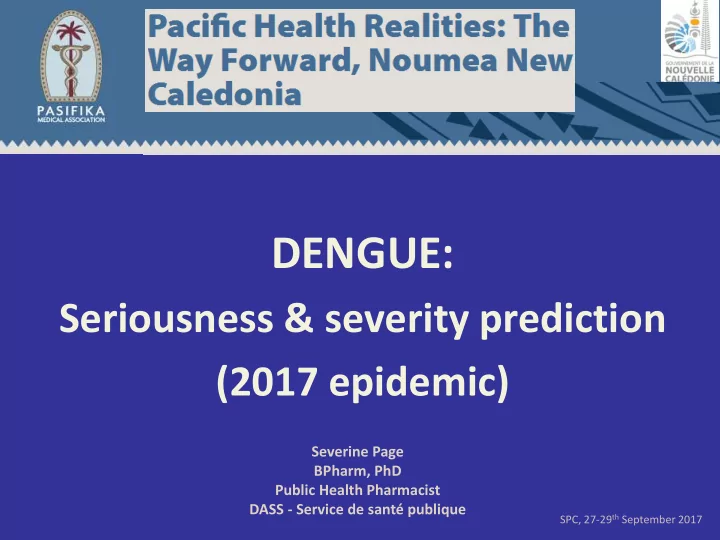

DENGUE: Seriousness & severity prediction (2017 epidemic) Severine Page BPharm, PhD Public Health Pharmacist DASS - Service de santé publique SPC, 27-29 th September 2017
New Caledonia Epidemiologic surveillance for dengue : o Mandatory declaration of disease (43 diseases including arboviruses) o Syndromic surveillance for influenza, gastroenteritis and arboviruses (24 doctors participate) o Non specific surveillance ( A&E data, temperature measurements , drug consumption, air quality measurements) o Hospital data on dengue o All medical doctors: declaration of unexpected progression/outcomes On 1 st January 2016 : 274 579 inhabitants. 74% in South province SPC, 27-29 th September 2017
Dengue history in NC 2013 10’522 2009 8’410 2003 2017 5’673 4’489 1998 2008 1996 2’612 1’179 2’121 2012 2016 718 693 Seroprevalence study conducted in 2013: => 50.3% (IC95% [50.0-50.6]) Amongst seropositive individuals, only 45.4% reported having had a previous dengue infection. SPC, 27-29 th September 2017
DENGUE: Seriousness & severity prediction Triple Dengue Epidemic January – August 2017 • 4489 dengue cases (53% confirmed, 4% probable, 43% possible) • 597 hospitalisations (13,3%) • 11 fatal cases (0,25%*): ~1,4 deaths/month Can we identify risk factors which are predictive of severity? *WHO: There is no specific treatment for dengue/ severe dengue, but early detection and access to proper medical SPC, 27-29 th September 2017 care lowers fatality rates below 1%
DENGUE: Seriousness & severity prediction What does the WHO tell us? Criteria for severe dengue : • Severe plasma leakage leading to shock or fluid accumulation with respiratory distress • Severe bleeding • Severe organ impairment (liver, heart, kidney, brain) SPC, 27-29 th September 2017
DENGUE: Seriousness & severity prediction What does the WHO tell us? The warning signs of severe dengue are • Abdominal pain or tenderness • Persistent vomiting • Clinical fluid accumulation • Mucosal bleeding • Lethargy or restlessness • Liver enlargement >2cm • Increase in haemtocrit concurrent with a rapid decrease in platelet count SPC, 27-29 th September 2017
DENGUE: Seriousness & severity prediction What does the WHO tell us? Hypothesised increased risk for severe dengue: • Single previous infection with dengue > 2 years • Previous infection with Zika SPC, 27-29 th September 2017
DENGUE: Seriousness & severity prediction What can we learn from this year’s epidemic? The study involves the DASS, the CHT, the Pasteur Institute Data collection: • Classification of cases • Patient characteristics & all relevant variables Data analysis: • Univariate analyses of all variables • Multivariate analyses of all variables SPC, 27-29 th September 2017
DENGUE: Seriousness & severity prediction What can we learn from this year’s epidemic? Aims of the study Identification of low cost & easily available composite variables (signs & symptoms) for the early identification of patients at risk of developing a severe form of dengue Ensuring rapid & adequate medical surveillance & treatment SPC, 27-29 th September 2017
DENGUE: Seriousness & severity prediction Classification of cases Characteristics & variables • Age, sex, ethnic origin H : Hospitalised NH: Not hospitalised • Medical & drug histories Deaths • Biochemical analyses at various Severe time-points (serotyping, blood Serious counts, LFTs …) • Clinical signs & symptoms Non-Severe • Type of medical care (community, hospital, ICU, transfusion…) • Outcomes Non- Serious SPC, 27-29 th September 2017
DENGUE: Seriousness & severity prediction What does this year’s epidemic tell us so far*? 42% of cases with 1 or more warning signs, developed a severe form of dengue Serious and/or severe cases: • Serious & severe: 17% had acute hepatitis • Serious & severe: ~51% had pre-existing chronic diseases (CV & obesity) versu s 35% in non-severe cases (non-serious & non-severe) • Amongst severe cases, 35% had none of the warning signs SPC, 27-29 th September 2017 *Preliminary results, the study is ongoing
DENGUE: Seriousness & severity prediction Hospitalised dengue cases (n=284/400) No warning signs Warning signs (n=77) (n=207) 42% (n=87) 58% 14% 21% (n=120) 65% Severe, serious (n=11) (n=16 ) (n=50) Dengue (n=103) Non-serious Non-severe , serious dengue (n=50) Dengue (n=131)
DENGUE: Seriousness & severity prediction What does this year’s epidemic tell us? Fatal cases (n=11): • 45,5% had abdominal pain or tenderness 1 st dengue infection n= 3/11, 2 nd dengue infection n=5/11, • undetermined yet n= 3/11 • No significant difference between serotypes 1, 2 & 3 (p=0,16) • No particular age group stands out, no differences between sexes or ethnic groups SPC, 27-29 th September 2017
DENGUE: Seriousness & severity prediction The way forward: Communication: • Modification of the dengue declaration form • Develop ways to ensure declaration forms are completed • Inform all medical doctors of new criteria for hospital referral Vaccination: • New Caledonia does not (yet) meet the WHO criteria for vaccination of the population (≥ 9 years) against dengue SPC, 27-29 th September 2017
Recommend
More recommend